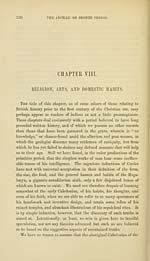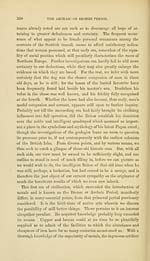Download files
Complete book:
Individual page:
Thumbnail gallery: Grid view | List view

URLIGION, ARTS, AND DOMESTIC HABITS. 387
liroiizc Period ever carried civilisation so far as materially to affect
the social character of the community. The patriarchal system of
tribes or clans, we may presume, continued nearly as wo know them
to have existed at the first dawn of written history, or, at most, were
only modified by the union of a greater or less number of petty tribes
under some general chief Many improvements on the accommoda-
tion and conveniencies of the native hut and its furnishings would
necessarily result from the possession of metallic tools. With these
only could the art of the carpenter be developed, and the implements
of husbandry and the chase, as well as the weapons of war, be moulded
into useful and convenient forms. The clothing also, we have seen,
was aided by the ingenuity and skill of feminine arts. The skins of
the deer or the wild bull, as well as of the fox, the hare, and the
smaller fur-clad animals, would thus be superseded in part, and
fashioned, where they were retained, with such improved taste as
made them correspond to the beautiful ornaments of the period. Of
very much of this all evidence has disappeared, but enough remains
to prove that the Caledonian of the Bronze Period was no naked
painted savage. Whether the ingenious knitters of the garments, the
precious fragments of which have occasionally been rescued from the
tumuli, had learned to adorn them with any interwoven parti-colours
may be doubted ; but the learned Scottish antiquaiy, Dr. Jamieson,
has already suggested the Gaelic breac, signifying parti-coloured, and
breacan, a tartan plaid, as perhaps the true source of derivation of
the name Gallia Braccata, which would thus refer to the colour rather
than to the fashion of the Celtic dress. We know certainly, from the
sculptures on Trajan's column, that the Bracce were not so unfamiliar
to the Romans as to be adopted as the peculiar characteristic of a
single race. It is to be borne in remembrance, however, that in so far
as this archaeological period is strictly defined to include only the era
of Archaic art, and the working in gold, copper, and bronze, prior to
the knowledge or economic use of iron, it must be assigned to an epoch
which had drawn to a close before the Britons were known to the
Romans, unless by vague traditions indirectly acquired through Car-
thage or Spain, or by the imperfect notices of the Cassiterides to be
found in the pages of early Greek writers.
An interesting inquiry suggests itself in relation to this as to all
unknown states of society — What was the social position of woman ?
To this the answer we can at present give is very uncertain. But the
Y
liroiizc Period ever carried civilisation so far as materially to affect
the social character of the community. The patriarchal system of
tribes or clans, we may presume, continued nearly as wo know them
to have existed at the first dawn of written history, or, at most, were
only modified by the union of a greater or less number of petty tribes
under some general chief Many improvements on the accommoda-
tion and conveniencies of the native hut and its furnishings would
necessarily result from the possession of metallic tools. With these
only could the art of the carpenter be developed, and the implements
of husbandry and the chase, as well as the weapons of war, be moulded
into useful and convenient forms. The clothing also, we have seen,
was aided by the ingenuity and skill of feminine arts. The skins of
the deer or the wild bull, as well as of the fox, the hare, and the
smaller fur-clad animals, would thus be superseded in part, and
fashioned, where they were retained, with such improved taste as
made them correspond to the beautiful ornaments of the period. Of
very much of this all evidence has disappeared, but enough remains
to prove that the Caledonian of the Bronze Period was no naked
painted savage. Whether the ingenious knitters of the garments, the
precious fragments of which have occasionally been rescued from the
tumuli, had learned to adorn them with any interwoven parti-colours
may be doubted ; but the learned Scottish antiquaiy, Dr. Jamieson,
has already suggested the Gaelic breac, signifying parti-coloured, and
breacan, a tartan plaid, as perhaps the true source of derivation of
the name Gallia Braccata, which would thus refer to the colour rather
than to the fashion of the Celtic dress. We know certainly, from the
sculptures on Trajan's column, that the Bracce were not so unfamiliar
to the Romans as to be adopted as the peculiar characteristic of a
single race. It is to be borne in remembrance, however, that in so far
as this archaeological period is strictly defined to include only the era
of Archaic art, and the working in gold, copper, and bronze, prior to
the knowledge or economic use of iron, it must be assigned to an epoch
which had drawn to a close before the Britons were known to the
Romans, unless by vague traditions indirectly acquired through Car-
thage or Spain, or by the imperfect notices of the Cassiterides to be
found in the pages of early Greek writers.
An interesting inquiry suggests itself in relation to this as to all
unknown states of society — What was the social position of woman ?
To this the answer we can at present give is very uncertain. But the
Y
Set display mode to: Large image | Transcription
Images and transcriptions on this page, including medium image downloads, may be used under the Creative Commons Attribution 4.0 International Licence unless otherwise stated. ![]()
| Early Gaelic Book Collections > J. F. Campbell Collection > Archaeology and prehistoric annals of Scotland > (379) |
|---|
| Permanent URL | https://digital.nls.uk/78375842 |
|---|
| Description | Volumes from a collection of 610 books rich in Highland folklore, Ossianic literature and other Celtic subjects. Many of the books annotated by John Francis Campbell of Islay, who assembled the collection. |
|---|
| Description | Selected items from five 'Special and Named Printed Collections'. Includes books in Gaelic and other Celtic languages, works about the Gaels, their languages, literature, culture and history. |
|---|

